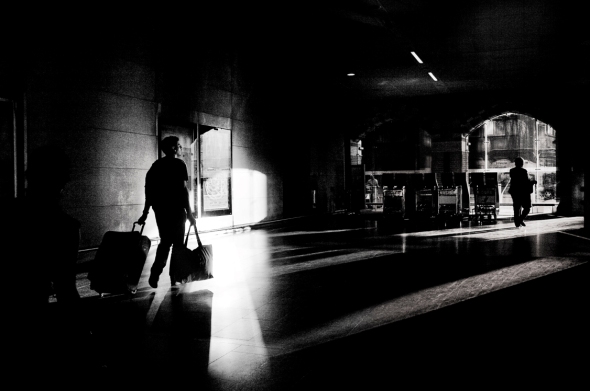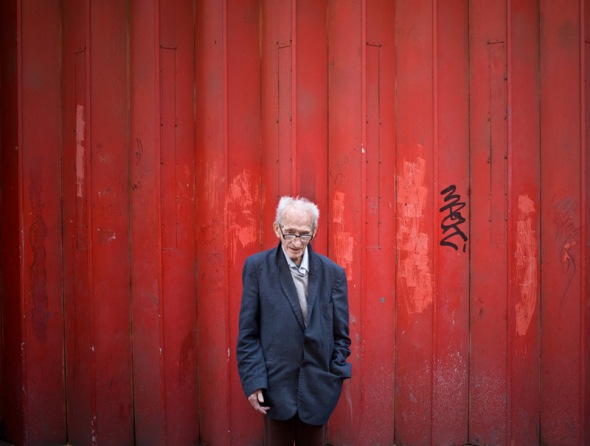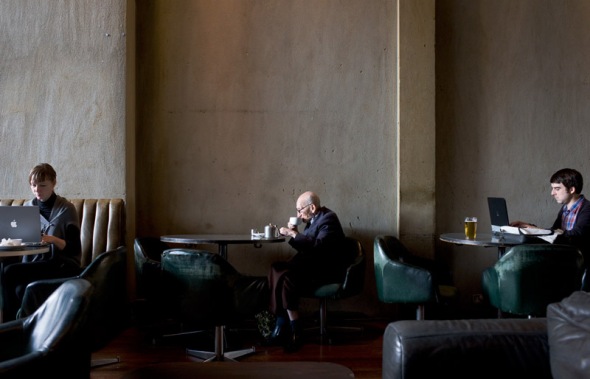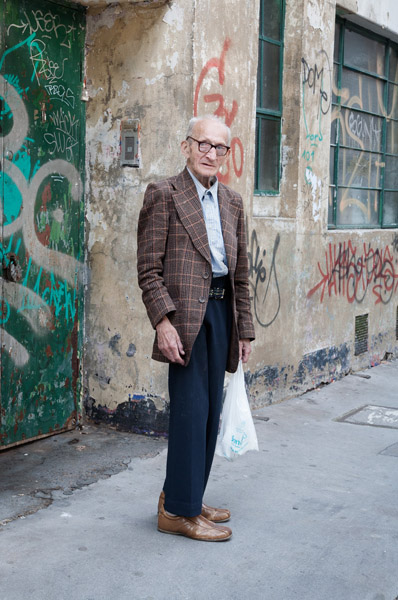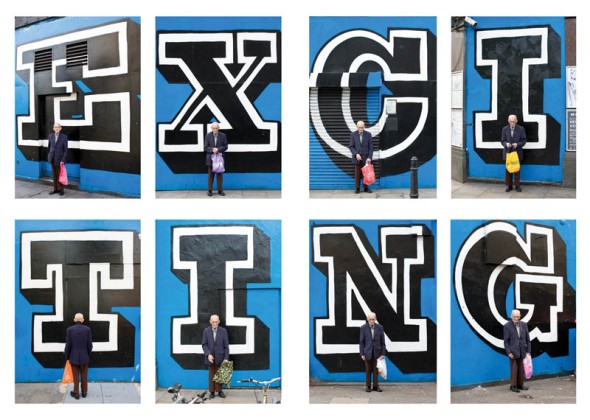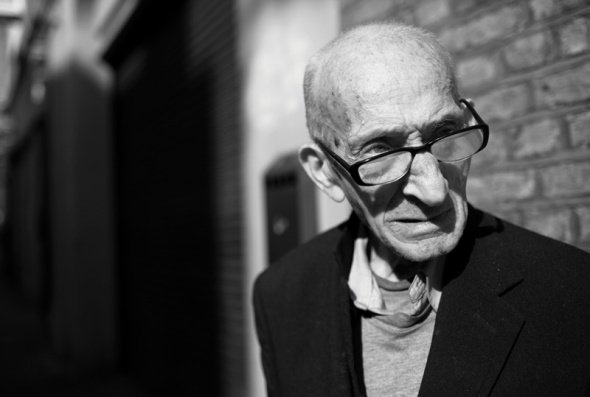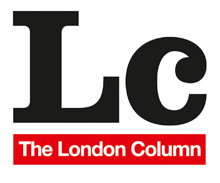A thought for the Undead.
Posted: October 31, 2013 Filed under: Catastrophes, Funereal, Parks, Tall Tales | Tags: adventure playground, buried alive, cholera, Halloween, Rotherhithe, The Not Really Dead, The Undead Comments Off on A thought for the Undead.Playground, Rotherhithe. © David Secombe 1988.
From The Lancet, August 23, 1884:
Burying Cholera Patients Alive
It is not so much undue haste as inexcusable carelessness that must be blamed for the premature burying of persons who are not really dead. Such heedlessness as alone can lead to the commission of this crime is not a shade less black than manslaughter. We speak strongly, because this is a matter in regard to which measures ought to be at once taken to render the horrible act impossible, and to dismiss all fear from the public mind. If it be a fact, as would seem to be indisputable, that during the last few weeks there have been cases we will not attempt to say how many or how few of burying alive, a scandal and a horror, wholly unpardonable in the last quarter of the nineteenth century, have to be faced; and the sooner the full truth is known and rules of safety established the better.
Let it be once for all decided that measures shall be taken to ascertain the fact of death before burial. Why not revert to the old practice, and always open a vein in the arm after death, or pass a current of electricity through the body before the coffin is finally screwed down? It may be held that these unpleasant resorts are unnecessary. We do not think they are. In any case enough is known of the possibilities of ‘ suspended animation’ to render it unsafe to bury until the evidences of an actual extinction of life are unmistakable ; and, as it is impossible to wait until decomposition sets in in all cases of death from infectious diseases, it would be prudent to adopt what must certainly be the least of evils.
… our obligatory Halloween post. See also: London Gothic, Halloween, The Haunted House.
King’s Cross Stories.
Posted: October 28, 2013 Filed under: Fictional London, London on film, Transport | Tags: Andrew Martin, Channel Tunnel Rail Link, Dombey and Son, Kings Cross, Mrs Wilberforce, St. Pancras, The Ladykillers, Tim Marshall Comments Off on King’s Cross Stories.St Pancras, Midland Road exit. © Tim Marshall.
Andrew Martin, Notes From The Railways, The Independent, Aug 31 2006:
If, like me, you cycle through King’s Cross most days, the description of Staggs’s Gardens in ‘Dombey and Son’ will seem familiar: ‘…bridges that lead nowhere; thoroughfares that were wholly impassable; Babel towers of chimneys wanting half their height; temporary wooden houses and enclosures, in the most unlikely situations…’
When you remember that a Stag was a railway speculator, that Staggs’s Gardens is supposed to be in Camden, the whole scene is a remarkable prefiguring of the bringing of the Channel Tunnel Rail Link into St Pancras and the associated works, such as the transformation of the streets east of King’s Cross into ‘Regent Quarter’ (which is somehow ten times more irritating as a name than ‘Regent’s Quarter’ would have been) and the development of the old goods yards north of King’s Cross.
Corner of York Way. © Tim Marshall
The developers contend that ‘no one can be nostalgic for the old King’s Cross.’ Well, that depends what you mean by ‘old’. There was so much shilly-shallying over whether King’s Cross or St Pancras should receive the CTRL that the area has been blighted for at least twenty years. (And many locals, incidentally, still wonder why Eurostar is coming into North London at all, given that South London is closer to France, and that the Waterloo terminus seems to be doing perfectly well). Immediately before the blight, the area was, according to Albert Beale of Houseman’s book shop on Caledonian Road, ‘pleasantly seedy’, as opposed to the heart of darkness, which it became.
King’s Cross, Pancras Road exit 2. © Tim Marshall.
Pre-blight, there were dark pubs where the beer mat tended to stick to the bottom of the glass, but King’s Cross was full of interesting transients, and with a sooty, crepuscular, train-haunted feel. When coming down from York as a teenager, I would drink in two wonderful old pubs in the south end of York way. The first was the Duke of York. It’s now called ‘Offshore’. Nipping in there the other day, I asked the Antipodean barmaid if she knew what the pub had been called before. A rather cruel experiment, I admit. ‘As far as I know it’s always been called Offshore,’ she said. I wonder if she also thinks it’s always been painted sky blue, and carried the slogan ‘Backpacking the world’ as it does today. This would certainly have made it stand out in 1860.
The second pub was The Railway Tavern, which had a black and white tv as late as about 1995, and was full of railway men, with those distinctive box-like shoulder bags. It is now hidden behind a hoarding, waiting to re-emerge, hung, drawn and Regent Quartered. I suppose it’ll be a Juice Bar.
McDonalds, Pentonville Rd. © Tim Marshall.
In Staggs’s Gardens, the nice old Ham and Beef Shop suddenly becomes the Railway Eating House, and the word ‘Railway’ is imposed on everything, even buildings that have as yet only a façade. My fear for King’s Cross tends in the opposite direction. I worry it will lose its railway character. I could be wrong. Most of the old buildings on the Railway Lands are to be preserved. And many of the locations used in the Ladykillers – which was made in 1955 when getting on for forty trains a day were still coming into the goods yard – still survive.
King’s Boulevard. © Tim Marshall.
The house of the old lady, Mrs Wilberforce, tended to flit around a bit. Some of the exteriors were done in Goldington Crescent, which is just as elegant as ever. For her rear garden (from where the bodies of the crooks were dumped onto coal trains) a patch of grass on top of Copenhagen Tunnel was used, and if you go along to the end of Vale Royal, off York Way, you can see the very spot. A man keeps horses there. The top of the tunnel is all black, cracked Gothic battlements, and the trains still thunder underneath towards the mass of X’s that form the points leading into King’s Cross.
I do hope this prospect is preserved. If not…well, The Ladykillers is just out on DVD.
© Andrew Martin. His new novel The Night Train to Jamalpur is published by Faber on 7 of November. Tim Marshall‘s album King’s Cross Stories is on his Tumblr site.
East Ender.
Posted: October 21, 2013 Filed under: Eating places, Graffiti, Health and welfare, Lettering, London Labour, Markets, Public Art, Street Portraits | Tags: Hoxton, Hoxton Mini Press, Joseph Markovitch, Martin Usborne, old East End 2 Comments© Martin Usborne.
Joseph Markovitch:
I was born right by Old Street roundabout on January 1st, 1927. Some of the kids used to beat me up – but in a friendly way. Hoxton was full of characters in those days. The Mayor was called Mr. Brooks and he was also a chimney sweep. Guess what? Before the coronation, he was putting up decorations and he fell off a ladder and got killed. Well, it happens. Then there was a six-foot tall girl, she was really massive. She used to attack people and put them in police vans. Maria was her name. Then there was Brotsky who used to kill chickens with a long stick. His son’s name was Monty. That’s not a common one is it? ‘Monty Brotsky’.
© Martin Usborne
I worked two years as a cabinet maker in Hemsworth Street just off Hoxton market. But when my sinuses got bad I went to Hackney Road putting rivets on luggage cases. For about twenty years I did that job. My foreman was a bastard. Apart from that it was OK. But if I was clever, very clever, then I would have liked to be an accountant. It’s a very good job. And if I was less heavy … you know what I’d like to be? I’d like to be a ballet dancer. That would be my dream.
© Martin Usborne
I don’t mind people taking pictures of me. But I wouldn’t let a girl take a picture of me. She might have a boyfriend. I don’t want any trouble. And who knows, he might think she wants to run off with me. You got to be careful where you go nowadays. Martin, if you want to take this picture you had better be quick. I don’t take a good picture when my bladder is full.
© Martin Usborne
If I try, I can imagine the future. It’s like watching a film. Pavements will move, nurses will be robots and cars will get smaller and grow wings … you’ve just got to wait. They will make photographs that talk. You will look at a picture of me and you will hear me say: ‘Hello I’m Jospeph Markovitch’ and then it will be me telling you abut things. Imagine that! I also have an idea that in about fifty years Hoxton Square will have a new market with an amazing plastic rain cover. So if it rains the potatoes won’t get wet. I don’t know what else they will sell. Maybe bowler hats. Nothing much changes round here in the end.
© Martin Usborne.
There’s no point crying about things is there? People don’t see you when you’re sad. Best just to keep walking.
Do you know that I can’t eat lettuce? I’ve got no teeth, not for ten years. It’s hard to like lettuce if you haven’t got teeth.
… taken from I’ve Lived In East London for 86.5 Years, photographs by Martin Usborne, the debut publication of Hoxton Mini Press. More details may be found on their Kickstarter page.
A Short Walk Down The Old Kent Road.
Posted: October 14, 2013 Filed under: Class, Public Art, Pubs, Tall Tales | Tags: Andrew Martin, Dun Cow, gentrification, Old Kent Road, only fools and horses, Pink Tank, Thomas A Becket 5 CommentsHoly Ghost Zone, Old Kent Road. © David Secombe 2008.
Andrew Martin:
When playing Monopoly my father was always determined to acquire Old Kent Road and Whitechapel, and to build on them as soon as possible. It’s the most modest portfolio on the board, with houses on Old Kent Road, as I remember, costing little more than a hotel on Mayfair. ‘You might laugh,’ my father would tell us in baleful tones, ‘but everybody always lands on Old Kent Road.’
I’m interested in the Old Kent Road as a sort of social counterweight to Hampstead, but my friend David, a South London partisan, is a genuinely keen on it, and gave me a guided tour this week.
Tesco, Old Kent Road. © David Secombe 2004.
‘When the evening sun’s like this,’ he said cheerfully, as we skirted a sofa that had been thoughtfully set out on the pavement, ‘it’s got a sort of I’m-in-a-scary-part-of-LA charm.’ We were walking past the Old Kent Road’s array of cosmopolitan food shops, beauty parlours, international cash transfer places, evangelical ministries, van washing businesses. As the cars screamed by, David would stop every now and again to photograph the lowering clouds over some light industrial unit or brutalist block of flats. He seemed particularly taken with the visual possibilities of the flyover at the southern end of the Road. ‘A friend of mine owns a flat that looks right on to that,’ he said enviously.
 .
.
Carpet Right, Old Kent Road. © David Secombe 2008.
I looked at a price list outside one of the Road’s pubs: it advertised a cocktail called a Slippery Nipple, consisting of Sambuca, Bailey’s and Grenadine. You could have a jug of Slippery Nipple for £12.50. Another sign forbade anybody wearing a hat to enter the pub. You knew there was some insight into human behaviour behind this, and that it had been won the hard way.
Re-branding exercise, Old Kent Road. © David Secombe 2008.
‘If Dickens were alive today he’d be down here all the time,’ said David as car came crawling noisily down the Road with only two of its tyres inflated. David then attempted, with windmilling arms, to direct the dazed-looking driver to a nearby sprawling depot called Madhouse Tyres.
As he did so, I reflected that the Old Kent Road does have the look of suburban LA or Chicago – that rangy wildness – and it occurred to me that this is what happens to British streetscapes when middle class vigilance is reduced and planning controls relaxed: they begin to look American.
Chinese Elvis restaurant, Old Kent Road. © David Secombe 2002.
David pointed out East Street, which goes off the Old Kent Road. Its market features in the opening credits of ‘Only Fools and Horses’, in which Rodney and Del Boy inhabit a tower block inevitably called Nelson Mandela House. David took me to Mandela Way, which intersects with Old Kent Road, and where there is a small patch of green space occupied by a tank that has been painted pink and decorated repeatedly with the stencilled word ‘Scab’. ‘If this was North London,’ I marvelled, ‘there would be letters in the Hampstead and Highgate Express every week until it was taken away.’ ‘Really?’ said David, snapping away, ‘it’s been here for years.’*
Tank, Mandela Way. © David Secombe 2004.
In the streets off Old Kent Road, you never know what you’ll find: a battered looking Georgian house with an ice cream van parked in the front drive and a lone security camera staring at it; a tiny house with a sign saying ‘This property is protected by guard dogs’ – that’s dogs, plural; sudden bombsites with rampant buddleia, the scars of the Second World War still seemingly fresh. There are also surprising runs of pristine Georgian and Victorian houses with obviously middle class occupants.
Almshouses, Asylum Road, SE15. © David Secombe 2008.
You could argue that Old Kent Road is going upmarket. The famous old Dun Cow pub is now the Dun Cow Surgery, and the Thomas A Becket, the even more famous boxing pub, built on one of the many sites where the Canterbury pilgrims took liquid refreshment, is now an estate agency, a sign of the times to an extent almost ridiculous. ‘You’d think there’d be a plaque acknowledging what it used to be,’ I said to David. But he frowned and shook his head, ‘That’s one of the great things about the Old Kent Road,’ he said, as we trudged on, ‘a profound lack of sentimentality.’
.. .
.
Andrew Martin outside the Asylum Tavern, Asylum Road, off the Old Kent Road, at the end of the trip described in the foregoing article. © David Secombe 2004.
© Andrew Martin. This article originally appeared in Andrew’s Class Conscious column for The New Statesman in 2004.
(*The tank is a Soviet T-34 placed on Mandela Way as a protest by a disgruntled property developer following the rejection of a planning application.)

